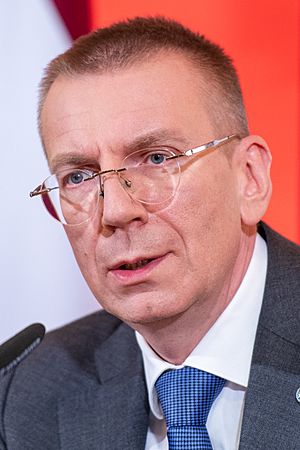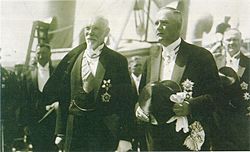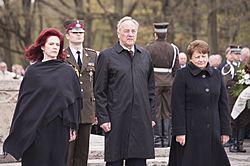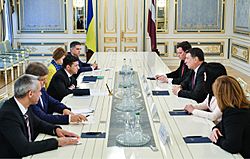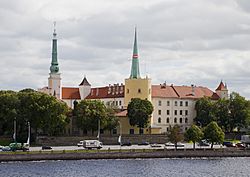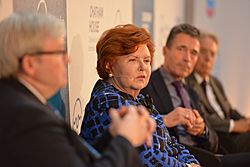President of Latvia facts for kids
Quick facts for kids President of the Republic of Latvia |
|
|---|---|

|
|
| Head of State | |
| Style | Mr. President (informal) His Excellency (diplomatic) |
| Member of | Latvian National Armed Forces |
| Residence | Riga Castle |
| Seat | Riga, Latvia |
| Appointer | Saeima |
| Term length | Four years,
renewable once consecutively
|
| Constituting instrument | Constitution of Latvia (1922) |
| Inaugural holder | Jānis Čakste |
| Formation | 14 November 1922 |
| Abolished | 1940–1991 |
| Deputy | Speaker of the Saeima |
| Salary | €54,732 annually |
The President of Latvia (in Latvian, Latvijas Valsts prezidents) is the head of state for the Republic of Latvia. This person is also the commander-in-chief of Latvia's National Armed Forces.
The president serves for four years. Before 1999, the term was three years. A president can be elected more than once, but not more than twice in a row. If the president's position becomes empty, the speaker of the Saeima (Latvian Parliament) takes over. For example, after Jānis Čakste died in 1927, Pauls Kalniņš, the speaker, briefly acted as president.
The president of Latvia has important duties, but does not have all the power like some other presidents. Their role is more than just ceremonial, unlike in Estonia. The president shares power with the government and prime minister. However, the president is not directly responsible for their actions in the same way. Their orders usually need to be signed by a government member, often the prime minister, to be valid.
The current president is Edgars Rinkēvičs. He was Latvia's foreign minister before. He was elected by the Saeima on May 31, 2023. He started his four-year term on July 8, 2023.
Contents
History of the Presidency
How the President's Role Began
The idea of a President for Latvia was first planned in the Satversme (Constitution). This important document was adopted on February 15, 1922. Before the Constitution was fully in place, the head of the Parliament acted as the head of state.
For example, Jānis Čakste was the chairman of the People's Council of Latvia. He acted as head of state from Latvia's independence day until the Constitutional Assembly met. Later, as president of the Constitutional Assembly, he continued these duties until the Saeima (Parliament) gathered.
Early Presidents of Latvia
On November 14, 1922, the first Saeima elected Jānis Čakste as the first President of Latvia. He took his oath of office on Independence Day, November 18. Čakste was re-elected in 1925.
After Čakste passed away in 1927, Gustavs Zemgals was elected president. He served one term and chose not to run again. Then, Alberts Kviesis was elected in 1930 and re-elected in 1933.
Kviesis remained president even after a coup d’état in May 1934. This coup changed Latvia from a democracy to an authoritarian system. When Kviesis's second term ended in 1936, the government decided that Prime Minister Kārlis Ulmanis would take over the president's role. Ulmanis then held both positions until the Soviet occupation in June 1940.
The Presidency During Occupation
Even though the Soviet Union occupied Latvia in 1940, Latvia's official laws did not change. Latvia continued to be recognized as a country under international law. During this time, Latvian diplomats continued to represent Latvia from other countries.
There were efforts to bring back Latvia's independence during the occupation. In 1944, the Latvian Central Council declared that Pauls Kalniņš, the Speaker of the last elected Saeima, was the acting president. After Kalniņš died, Jāzeps Rancāns, a Vice-Speaker, took over as acting president until his death in 1969.
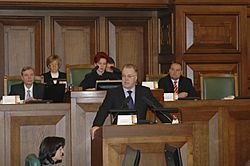
Restoring the Presidency
After Latvia regained its independence in 1990, the president's role was not immediately brought back. During this time, Anatolijs Gorbunovs, the Chairperson of the Supreme Council of Latvia, acted as head of state.
The president's office was fully restored when the Saeima met on July 6, 1993. On July 7, 1993, the Saeima elected Guntis Ulmanis as president. He took his oath the next day, July 8, which became the usual date for the oath. Ulmanis was re-elected in 1996.
Vaira Vīķe-Freiberga was elected in 1999, becoming Latvia's first female president. She was re-elected in 2003. Valdis Zatlers was chosen as president in 2007. He was the first president to lose his re-election bid. Andris Bērziņš was elected in 2011, followed by Raimonds Vējonis in 2015. Both Bērziņš and Vējonis chose not to run for a second term.
What the President Does
Main Powers from the Constitution
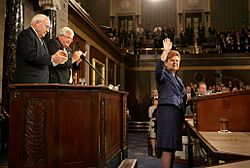
The president represents Latvia when dealing with other countries. They appoint Latvia's diplomats and welcome diplomats from other nations. The president also makes sure that international agreements approved by the Saeima are put into action (Article 41).
The president is the leader of Latvia's Armed Forces. If there is a war, the president appoints a Supreme Commander (Article 42).
The president declares war only if the Saeima decides to (Article 43).
If another country declares war on Latvia or invades, the president can take necessary steps to defend the country. At the same time, the president must immediately call the Saeima to decide on the war (Article 44).
The president can grant mercy to criminals whose court sentences are final. The rules for this are in a special law (Article 45).
The president can call and lead special meetings of the Cabinet of Ministers and set their agenda (Article 46).
The president, prime minister, or at least one-third of Saeima members can ask for Saeima meetings to be held (Article 20).
At the president's request, or that of ten Saeima members, the prime minister, or a minister, the Saeima can decide to hold a closed meeting (Article 22).
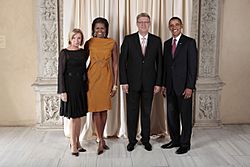
The president can suggest dissolving the Saeima. If this happens, the public votes in a referendum. If more than half vote for dissolution, the Saeima is dissolved, and new elections are held within two months (Article 48).
If the Saeima is dissolved, its members still serve until a new Saeima meets. However, the dissolved Saeima can only meet if the president asks it to, and the president sets the agenda (Article 49).
The president is not politically responsible for their duties. Most of the president's orders must be co-signed by the prime minister or a minister. This person then takes full responsibility for the order. Exceptions are the order to dissolve the Saeima and inviting a candidate for prime minister (Articles 48, 56).
The president chooses the person who will form the Cabinet of Ministers (Article 56).
President's Role in Making Laws
The president has the right to suggest new laws (Article 47).
The president announces laws passed by the Saeima. This happens between 10 and 21 days after the law is passed. A law usually becomes active 14 days after it is announced, unless the law says otherwise (Article 69).
Within ten days of a law being passed, the president can ask the Saeima to rethink it. If the Saeima does not change the law, the president cannot object to it a second time (Article 71).
The president can delay the announcement of a law for two months.
The president must delay a law if at least one-third of Saeima members ask for it. This request must be made within ten days of the law being passed. The delayed law will then be put to a public vote if at least one-tenth of voters ask for it. If no such request is made within two months, the law is announced. However, a public vote won't happen if the Saeima votes on the law again and at least three-quarters of all members approve it (Article 72).
If the Saeima decides a law is urgent by a two-thirds vote, the president cannot ask for it to be reconsidered. It also cannot be put to a public vote and must be announced within three days (Article 75).
At least one-tenth of voters can propose a new law or a change to the Constitution. They submit it to the president, who then presents it to the Saeima (Article 78).
Other Presidential Powers
The president has the special right to grant mercy to criminals, as stated in the Law on Clemency.
Other laws also give the president duties and rights:
- The president attends the oath-taking of judges.
- The president leads the National Security Council.
- The president can receive secret state information.
- The Saeima approves and removes the Commander of the National Armed Forces based on the president's suggestion.
- The president appoints and removes ambassadors.
- The president awards officer ranks in the military and can take them away for serious crimes.
- The president can relieve soldiers from active duty during peacetime.
- In times of war or invasion, the president acts according to the National Defence Plan. They issue orders to the Armed Forces and government, call a Saeima meeting, and appoint the senior commander.
- The president can get information from government offices, following rules about how that information is used.
- The president is a member of the National Security Council and calls its meetings.
- The president awards state honors.
How the President is Elected
Who Can Be President?
Anyone who is a full citizen of Latvia and is at least 40 years old can be elected president. A person with citizenship in two countries cannot be president.
The president cannot hold any other job at the same time. If a Saeima member is elected president, they must give up their seat in Parliament.
Elections and Taking Office
To be elected president, a person needs more than half of all votes from the Saeima members in the first round.
If no one wins in the first round, more rounds are held. If no one wins after the second round, the candidate with the fewest votes is removed in each following round until someone gets at least 51 votes. The Speaker of the Saeima leads this election process.

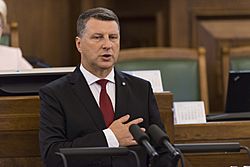
When the president takes office, they say a special oath: "I swear that all of my work will be dedicated to the welfare of the people of Latvia. I will do everything in my power to promote the prosperity of the Republic of Latvia and all who live here. I will hold sacred and will observe the Constitution of Latvia and the laws of the State. I will act justly towards all and will fulfil my duties conscientiously."
Presidential Term and Residence
Term Limits
The Saeima elects the president for a four-year term (Article 35). A person cannot be president for more than eight years in a row.
When the Office is Empty
If the president resigns, dies, or is removed from office before their term ends, the Speaker of the Saeima takes over. They act as president until a new one is elected. The Speaker also takes over if the president is out of Latvia or cannot do their job for any reason.
The Saeima can remove the president from office. This requires a closed meeting and a vote of at least two-thirds of all Saeima members.
If the president suggests dissolving the Saeima, but more than half of the public votes against it in a referendum, then the president is removed from office. The Saeima then elects a new president to finish the remaining term.
Where the President Lives and Works
Riga Castle has been the official home and office of the President since 1922. It was expanded and renovated in the 1930s. During the Soviet occupation, it was used as a youth center. By 1994, it was renovated again for the president. It has many rooms for guests, a large office, and museum halls for diplomatic gifts.
The 3-story Jūrmala Residence is the president's official retreat. It was built in 1971 for Soviet officials and renovated for the president in 1993. It has a large park, an indoor swimming pool, a guest room, and a private beach.
During renovations at Riga Castle, presidents have used other temporary residences, like the Maikapars' House and the House of the Blackheads.
How the President Travels
For daily travel, the president uses a Lexus car. For longer trips within Latvia, they use a Latvian Armed Forces helicopter. For international travel, the president uses an AirBaltic plane, which is Latvia's state-owned airline.
After the Presidency
After their term, former presidents may retire from politics. However, some continue to be active. For example, Vaira Vīķe-Freiberga still gives lectures and teaches about politics in Latvia and other countries.
Every former president receives an office, staff, a car, security, and an apartment in Riga. They also receive a pension based on their salary.
List of Presidents
- Parties
DC LSDSP LZS LTF LC ZZS LZP None Unity
- Status
Acting President
| No. | Portrait | Name (Birth–Death) |
Term of office | Political party | |
|---|---|---|---|---|---|
| 1 |  |
Jānis Čakste (1859–1927) |
17 December 1918 | 14 November 1922 | Democratic Centre |
| 14 November 1922 | 14 March 1927 | ||||
| — |  |
Pauls Kalniņš (1872–1945) |
14 March 1927 | 8 April 1927 | Latvian Social Democratic Workers' Party |
| 2 |  |
Gustavs Zemgals (1871–1939) |
8 April 1927 | 11 April 1930 | Democratic Centre |
| 3 |  |
Alberts Kviesis (1881–1944) |
11 April 1930 | 15 May 1934 | Latvian Farmers' Union |
| (3) | 16 May 1934 | 10 April 1936 | Independent | ||
| 4 |  |
Kārlis Ulmanis (1877–1942) |
11 April 1936 | 21 July 1940 | Independent |
| Occupation of Latvia (21 July 1940 – 21 August 1991) | |||||
| Pauls Kalniņš served as acting president from 1944 to 1945 | |||||
| Jāzeps Rancāns served as acting president from 1947 to 1969 | |||||
| — |  |
Anatolijs Gorbunovs (born 1942) |
21 August 1991 | 13 February 1993 | Popular Front of Latvia |
| (—) | 13 February 1993 | 8 July 1993 | Latvian Way | ||
| 5 |  |
Guntis Ulmanis (born 1939) |
8 July 1993 | 8 July 1999 | Latvian Farmers' Union |
| 6 |  |
Vaira Vīķe-Freiberga (born 1937) |
8 July 1999 | 8 July 2007 | Independent |
| 7 |  |
Valdis Zatlers (born 1955) |
8 July 2007 | 8 July 2011 | Independent |
| 8 |  |
Andris Bērziņš (born 1944) |
8 July 2011 | 8 July 2015 | Union of Greens and Farmers |
| 9 |  |
Raimonds Vējonis (born 1966) |
8 July 2015 | 8 July 2019 | Latvian Green Party |
| 10 |  |
Egils Levits (born 1955) |
8 July 2019 | 8 July 2023 | Independent |
| 11 |  |
Edgars Rinkēvičs (born 1973) |
8 July 2023 | Incumbent (Term ends on 8 July 2027) |
Unity |
See also
 In Spanish: Presidente de Letonia para niños
In Spanish: Presidente de Letonia para niños
- List of presidents of Latvia by age
- Lists of office-holders
- Prime Minister of Latvia


